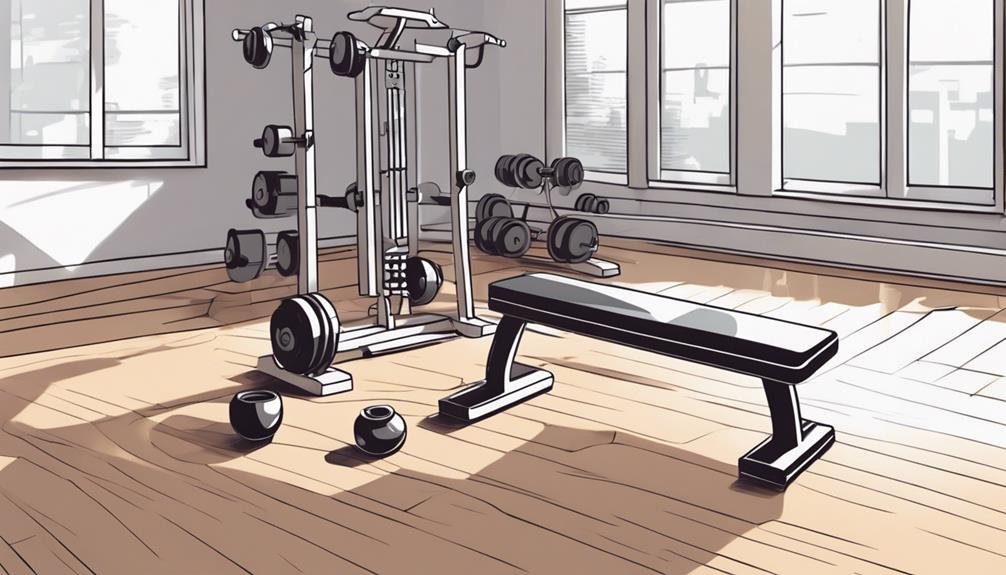10 Effective Workout Routines for Men Over 40
To get the most out of your workouts after 40, focus on strength, cardio, flexibility, and recovery. Aim for 3-4 sessions a week. Incorporate full-body strength routines with key exercises like squats and push-ups. For upper and lower body, include targeted exercises like dumbbell rows and lunges. Don't forget core stability workouts and flexibility routines, which are crucial for mobility. Integrating cardio is also essential for heart health—try mixing different activities. Prioritize rest and nutrition to support recovery and muscle growth. Stick around, and you'll discover more tips on effective routines tailored just for you.
Key Takeaways
- Prioritize full-body strength routines 2-3 times weekly to enhance muscle balance and maintain muscle mass as you age.
- Incorporate upper and lower body exercises like push-ups, squats, and deadlifts for comprehensive strength development.
- Include core stability workouts, such as planks and bird dogs, to improve balance and reduce injury risk.
- Integrate cardiovascular workouts for at least 150 minutes weekly to boost heart health and overall fitness.
Importance of Strength Training
Strength training is crucial for men over 40, as it helps maintain muscle mass, boost metabolism, and enhance overall health.
As you age, your body naturally loses muscle, which can lead to decreased strength and increased fat accumulation. By incorporating strength training into your routine, you can counteract these effects and guarantee your body remains strong and resilient.
You'll find that regular strength workouts not only improve your physical appearance but also increase your functional abilities, making everyday tasks easier. Additionally, lifting weights helps support bone density, reducing the risk of fractures.
You'll also enjoy mental benefits, like improved mood and reduced stress levels. Prioritizing strength training is an important step toward a healthier, more active lifestyle as you age.
Frequency of Workouts
To achieve ideal results, aim for a workout frequency of at least three to four times a week. This consistency helps improve strength, endurance, and overall health.
Here's a simple breakdown to guide your routine:
- Strength Training: Prioritize resistance exercises targeting major muscle groups. Aim for two to three sessions weekly.
- Cardiovascular Workouts: Incorporate cardio sessions, like brisk walking or cycling, at least two times a week to boost heart health.
- Flexibility and Mobility: Don't forget to include stretching or yoga once a week to enhance flexibility and prevent injury.
Full-Body Strength Routine

A full-body strength routine can effectively complement your workout frequency by targeting multiple muscle groups in a single session. This approach not only saves time but also enhances overall muscle balance, helping you feel stronger and more agile.
| Exercise | Sets | Reps |
|---|---|---|
| Squats | 3 | 10-12 |
| Deadlifts | 3 | 8-10 |
| Push-ups | 3 | 10-15 |
Incorporating these exercises into your weekly routine boosts your metabolism and increases bone density. You'll notice improvements in your daily activities, whether it's lifting groceries or playing with your kids. Remember, consistency is key, so aim to perform this routine 2-3 times a week for the best results!
Upper Body Focus
Focusing on your upper body can enhance strength and posture, making daily activities feel easier and more comfortable. Incorporating specific exercises into your routine is essential for building muscle and improving functionality.
Here are three key exercises to evaluate:
- Push-Ups: Great for targeting your chest, shoulders, and triceps. Start with modified versions if needed, then progress to standard push-ups.
- Dumbbell Rows: Strengthen your back and biceps. Use a bench for support and focus on squeezing your shoulder blades together.
- Overhead Press: This exercise works your shoulders and triceps. Use dumbbells or a barbell, ensuring you maintain a strong core throughout the movement.
Lower Body Strength Exercises

Building lower body strength is essential for improving balance, mobility, and overall functional fitness as you age. Incorporating exercises like squats, lunges, and deadlifts into your routine will target major muscle groups in your legs and glutes. Aim for 2-3 sets of 8-12 reps per exercise, focusing on form and control.
| Exercise | Sets | Reps |
|---|---|---|
| Squats | 2-3 | 8-12 |
| Lunges | 2-3 | 8-12 |
| Deadlifts | 2-3 | 8-12 |
Don't forget to warm up before your workouts and stretch afterward to enhance flexibility. Building a strong lower body will support your fitness goals and help prevent injuries.
Core Stability Workouts
Core stability workouts play an essential role in enhancing your overall strength and balance as you age. By focusing on your core, you can improve posture, reduce injury risk, and boost athletic performance.
Here are three effective core stability exercises you can incorporate into your routine:
- Plank: Hold a plank position for 30 seconds to a minute, keeping your body straight and engaging your core.
- Bird Dog: From all fours, extend one arm and the opposite leg while maintaining balance. Hold for a few seconds and switch sides.
- Dead Bug: Lie on your back with knees bent. Extend opposite arm and leg while keeping your lower back pressed into the floor. Return and switch.
These exercises will fortify your core and support your fitness journey.
Flexibility and Mobility

Improving flexibility and mobility is essential for men over 40 to maintain functional movement and prevent injuries as they age.
Incorporating regular stretching and mobility exercises into your routine can greatly enhance your overall performance. Focus on dynamic stretches before workouts to warm up your muscles, and static stretches afterward to improve flexibility.
Yoga and Pilates are excellent options, offering a combination of strength, balance, and flexibility training. You should also consider foam rolling to release tension in tight muscles.
Aim for at least 15-20 minutes of flexibility work three times a week. Remember, consistency is key; the more you practice, the more you'll notice improvements in your range of motion and daily activities.
Stay committed to your mobility journey!
Cardio Integration
Integrating cardio into your workout routine is essential for boosting heart health and enhancing overall fitness as you age.
To effectively incorporate cardio, focus on these three key strategies:
- Mix It Up: Combine different cardio activities like cycling, swimming, or jogging to keep things interesting and target various muscle groups.
- Set Goals: Aim for at least 150 minutes of moderate-intensity cardio weekly. Break it down into manageable sessions, like 30 minutes, five times a week.
- Listen to Your Body: Pay attention to how your body responds. Adjust the intensity and duration as needed to avoid overexertion.
Recovery Strategies

Embracing effective recovery strategies is essential for men over 40 to maintain performance and prevent injuries after workouts.
Prioritize rest days to allow your muscles to repair and grow stronger. Incorporate low-impact activities like walking or swimming on these days to promote blood flow without straining your body.
Stretching and foam rolling can help alleviate tightness, enhancing flexibility and reducing soreness. Don't underestimate the importance of sleep; aim for 7-9 hours each night to support overall recovery.
Hydration also plays a vital role, so drink plenty of water before, during, and after your workouts.
Nutrition for Optimal Results
Proper nutrition is essential for men over 40 to fuel workouts and enhance recovery, ensuring you get the most out of your fitness routine. To achieve ideal results, focus on these three key aspects:
- Protein Intake: Aim for lean proteins like chicken, fish, and legumes to support muscle repair and growth.
- Healthy Fats: Incorporate sources such as avocados, nuts, and olive oil to maintain hormone levels and improve joint health.
- Complex Carbohydrates: Choose whole grains, fruits, and vegetables to provide sustained energy throughout your workouts.
Questions
How Do Hormonal Changes Affect Workout Performance Over 40?
Hormonal changes can impact your energy levels, muscle recovery, and fat distribution. As you age, you might find it's harder to build muscle or recover quickly, so adjusting your workout routine becomes essential for maintaining performance.
Should I Consult a Doctor Before Starting a New Workout Routine?
Before diving into a new workout routine, it's wise to consult a doctor. You'll guarantee you're not just charging into the unknown, but rather setting a solid foundation for your fitness journey.
What Are the Best Warm-Up Exercises for Older Adults?
For older adults, gentle warm-up exercises like arm circles, leg swings, and ankle rolls work great. These movements increase blood flow, improve flexibility, and prepare your body for more intense activities, reducing injury risk.
How Can I Stay Motivated to Work Out Consistently?
Isn't it easy to lose sight of your fitness goals? To stay motivated, set clear objectives, track your progress, and celebrate small wins. Surround yourself with supportive people who inspire you to keep going.
Are There Specific Supplements Recommended for Men Over 40?
You might consider supplements like vitamin D, omega-3 fatty acids, and magnesium. These support overall health, boost energy, and aid recovery. Always consult with a healthcare professional before starting any new supplement regimen.
Conclusion
In your journey to stay fit after 40, remember that consistency is your best friend.
By mixing strength training, cardio, and flexibility work, you're not just maintaining your health; you're building a fortress of vigor around your body.
Embrace recovery and proper nutrition like a warm hug after a long day.
With these effective routines, you'll not only feel stronger but also more energized, proving that age is just a number in the game of fitness.

